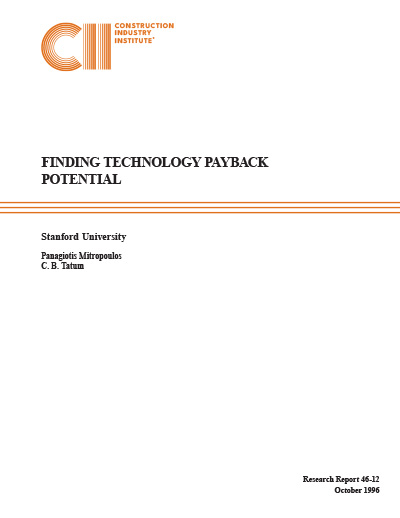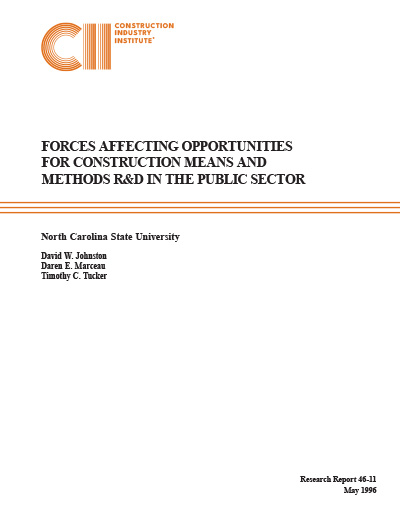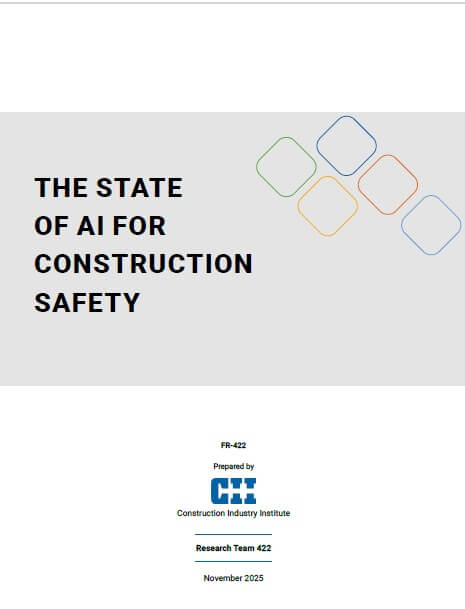
Finding Technology Payback Potential
In August 1993 the Construction Industry Institute formed the Technology Strategy Task Force “to develop a strategy to advance the industry through technology.” The task force identified the need to better understand how and why managers in construction firms make decisions to adopt or reject a new technology, what factors affect such decisions, and how existing industry conditions inhibit innovation. This report gives results from the research project sponsored by the task force to fill this need. The study focuses on construction means and methods technologies, which include information technologies for project control, product and process information and electronic communications, and physical technologies for fabricating and installing components.
To support developing effective strategies, this research focused on two key issues. First, how do Contractors make decision to adopt or reject a new technology? This identified the forces that drive contractors to adopt or reject a new technology and the criteria they use to decide. Second, the study identified the current industry conditions that inhibit the adoption of new technologies.
Findings regarding decision process
The study identified four major forces that drive decision processes regarding new technology. External requirements, such as pressures from owners, designers, competitors and regulators, drive the adoption of new technology. Priority problems drive new technology when existing methods cannot meet project requirements. Potential competitive advantage and technological opportunity to improve efficiency are the other two forces that drive adoption of new technology.
Factors related to the market, organizations, and projects influence the decision to adopt a new technology. Owners and designers’ pressures create the market forces. The organizational factors are top management’s attitude and the structures and policies in the contractors’ organizations that support innovation. Project factors include risk allocation, extent of cooperation between the parties, and freedom from costs and time pressures.
Findings regarding industry conditions
The second set of findings concern existing industry conditions that inhibit the rate of technological innovation. The findings also identify the reasons that cause these conditions. The most important conditions are: low pressures from owners, low pressures from designers, and reluctance of contractors to adopt new technologies.
The low pressures from owners are indicated by the following findings: owners do not specify means and methods technologies, owners do not use technological capabilities as criterion for contractor’s selection, and owners do not share technology risks and costs with the contractors. The primary reasons for this owners attitude are considering contractors responsible for means and methods, lacking information regarding technologies and benefits, and focusing on short-term project performance.
The low pressures from designers are supported by findings that designers do not specify means and methods technologies and designers do not consider construction methods in design. The primary reasons for this attitude are liability concerns, economic disincentives, and lack of awareness.
The research identified the following issues as the primary reasons for reluctance to adopt new technologies:
- Risk aversion
- Project cost and time pressures
- Uncertain competitive advantage from using new technologies
- Lack of corporate structure to support technology
- Lack of information regarding contractors’ technologies and benefits
Recommendations to increase innovation
The findings from the research and other task force activities identify the following changes as essential for increased technological innovation: increase owners’ demand, reduce designers’ disincentives, and increase contractor’s motivation.
Owners’ demand can create the necessary market forces for contractors to utilize value-adding technology. To foster such market forces owners should first increase knowledge of the benefits of new technologies and the opportunity costs of not using them. This will encourage changing the procurement paradigm, by using technological capabilities as criterion for contractors’ selection. Owners can also create a project environment that support innovation, through risk sharing and teamwork.
The first action needed for designers to promote and support construction innovation is for owners to select designers based on knowledge of construction means and methods in addition to expertise regarding product technologies. Owners can reduce the designers liability by sharing the risk involved in the implementation of a new technology. Owners can also remove designers’ economic disincentives by compensating for additional cost and time involved in innovation.
Decreasing contractors’ reluctance to pursue new technology begins with increase awareness of benefits and incentives to move beyond single project mentality. A technology clearinghouse could provide reliable information regarding the performance of new technologies, the actual costs, potential risks, as well as the best implementation methods. Contractors can also establish organizational mechanisms that support innovation. For this, management must allow time and resources for employees to test new technologies outside projects pressures, consider technological opportunities as part of business or project planning, and establish mechanisms to collect and disseminate information about innovative technical solutions and diffuse them to the organization.



